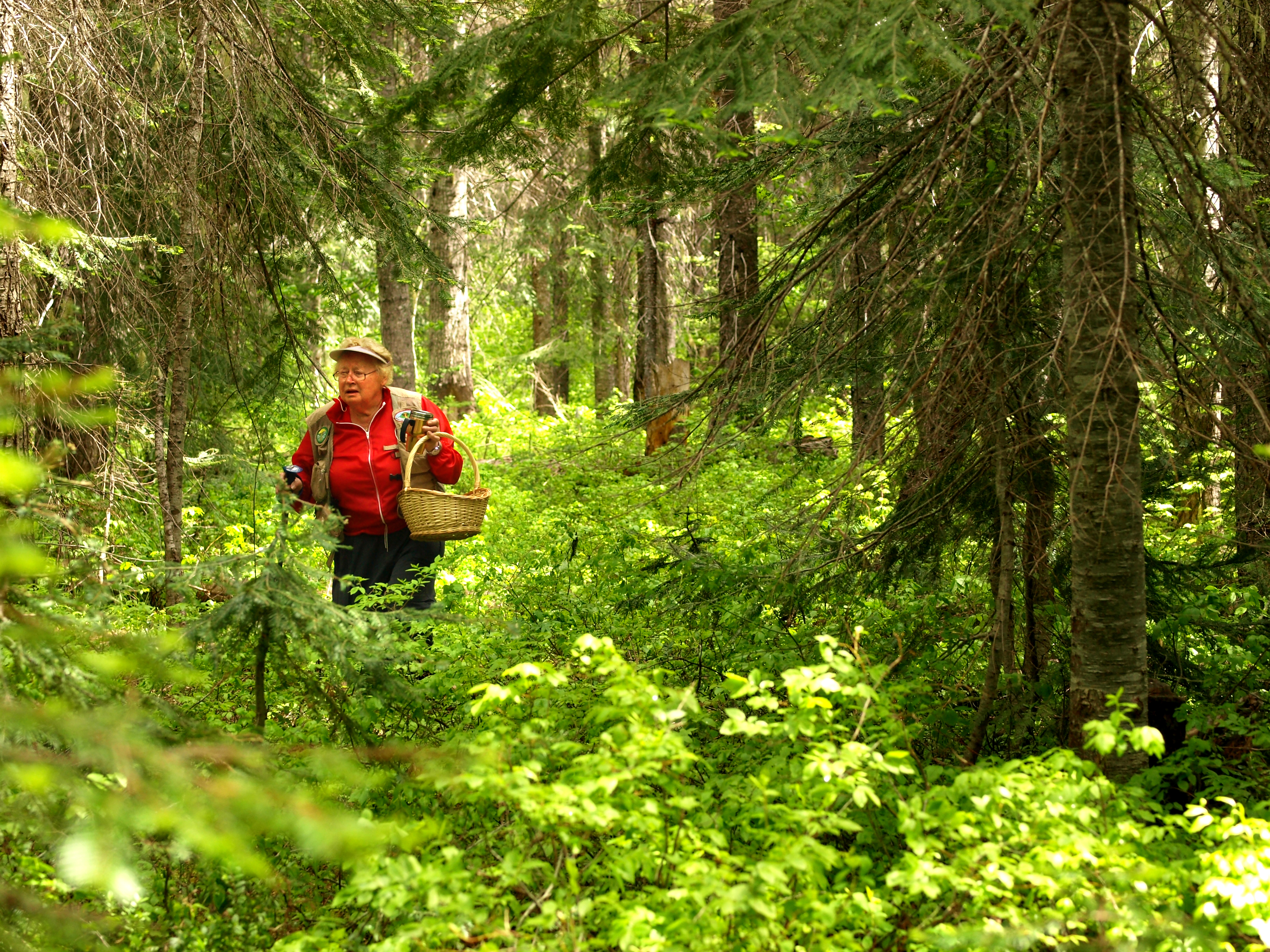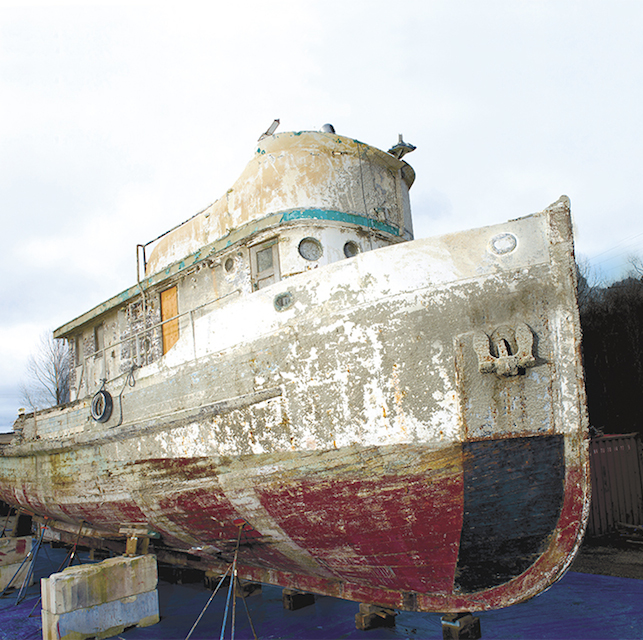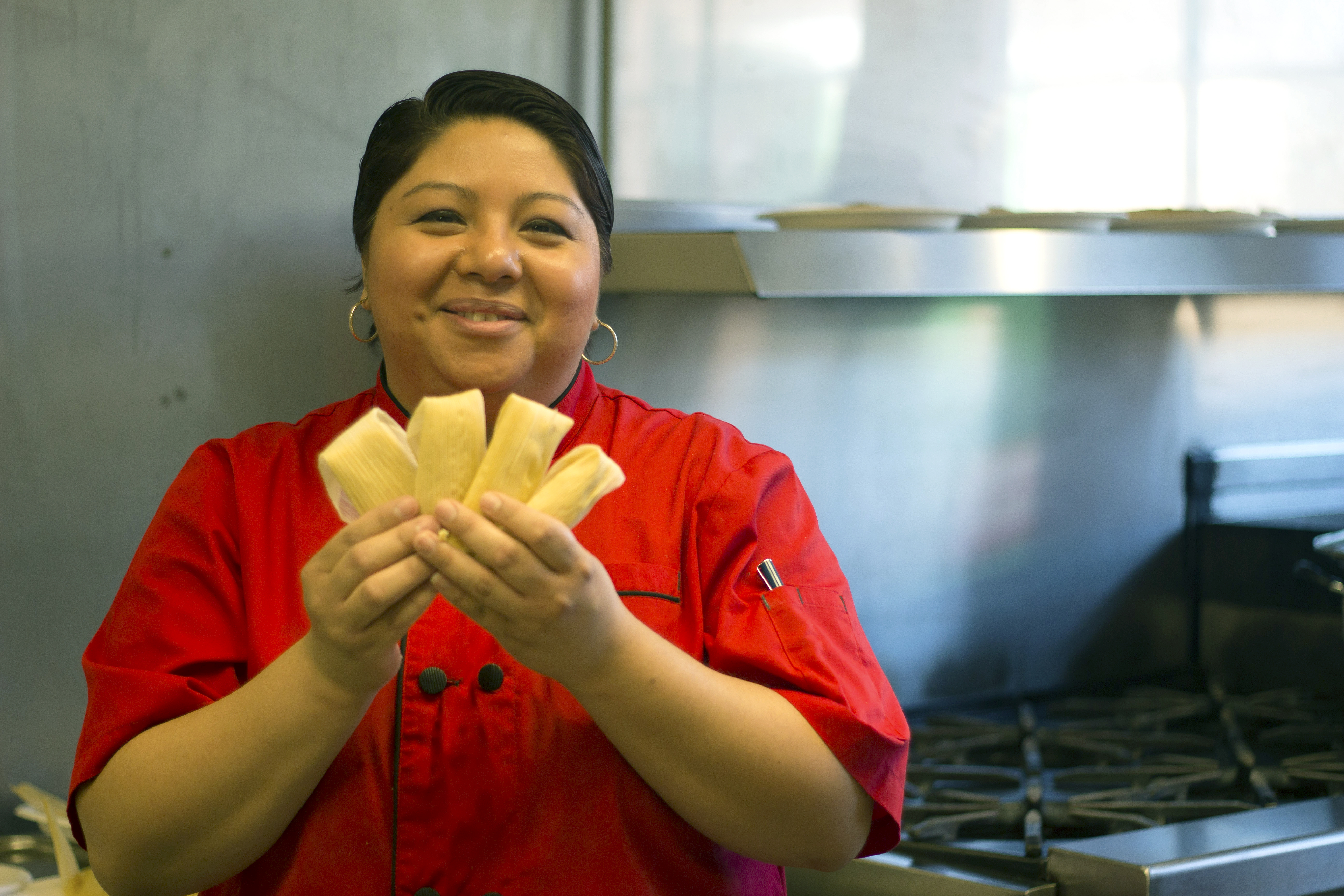On the eastern slopes of the Central Cascades, the last traces of snow are melting away and the tiny, delicate heads of morel mushrooms are pushing up through carpets of pine needles to greet the beginning of summer. Their emergence marks the start of one of the most prized mushroom-foraging times of the year, drawing hundreds of recreational and commercial mushroom pickers onto narrow Forest Service roads, hiking trails, and ORV paths to harvest their share of the venerable fungi. But this year, those passionate foragers will miss an ally, a teacher, and a friend, because last June 8, Hildegard Hendrickson, the godmother of Washington mushroom hunting, ventured among the burnt remains of a pine forest looking for morels and vanished.
I learned about Hendrickson’s disappearance in late April. I was researching a story on mushroom foraging—a seemingly fun hobby, the perfect combination of hiking, treasure hunting and cooking. After only a few minutes of researching how one might get involved, I came across the Puget Sound Mycological Society (PSMS), a nonprofit founded in 1964 that’s now one of the largest mushroom societies in the country. The society runs mushroom identification, or ID, clinics on Monday nights during the two prime mushroom seasons—starting in April and September—at the UW Center for Urban Horticulture. They provide novices and experts alike the opportunity to talk shop and have their mushrooms identified for free. Identification of mushrooms is of vital importance: Thousands of species exist, many are poisonous, and some that look identical to their edible counterparts will kill you if ingested.
As I made plans to visit the clinic, one thing continued to catch my eye: the name “Hildegard Hendrickson ID Clinic.” It sounded familiar, but I didn’t know why. A quick Google search brought up images of an older woman with short, curly gray hair tucked beneath the band of a tan visor. Her face is wrinkled and smiling; in her hands is a giant mushroom. A memory came flooding in.
It was a balmy June afternoon in 2010. Friends and I found something unusual in the backyard of our house in north Seattle. Between two fruit trees—which always managed to drop an impressive, and at times annoying, number of plums onto the scrappy patch of grass we called a yard—we found mushrooms: tan, phallic, brainy, and large. They were morels—one of the most sought-after mushrooms in the Pacific Northwest and beyond—but we didn’t know that then. A few minutes of Internet research led me to the PSMS and a phone number. When I called, Hendrickson answered.
She told me to pick the mushrooms and stop by her house, just a few blocks away. I found her in her garden, watering roses. She greeted me warmly, offered me icewater, and immediately identified the mushrooms as morels—one of which, she told me beaming, was the largest she’d ever seen. We had a pleasant conversation; I gave her the monster morel for one of her classes; and we parted ways. The interaction lasted 15 minutes, but it stayed with me.
Photo By Patrick HutchisonThe ID clinics were officially named after her this year, and scrolling through the PSMS website, I learned why: She was a longtime member who, tragically, went missing while on a hunt for morels, the same mushrooms she identified from my yard that June afternoon.
On Saturday, June 8, 2013, Hendrickson drove east from Everett on US 2 in her green Ford Focus, arriving at the Minnow Creek Trailhead near Basalt Peak in the early afternoon. Her drive up Chikamin Ridge Road to the Minnow Creek trailhead would have been a bumpy one. The narrow gravel Forest Service road would have just been rid of the last hangings-on of winter snow patches, leaving everything underneath muddy and soft. The year before, fires had raged through this area. Though it is extremely difficult to forecast the locations of wild mushroom patches, morels often grow in areas that have suffered wildfires. Normally much harder to find and beloved for their dense, meaty texture and rich flavor, fire-burn morel patches are like pots of gold at the end of a smoky rainbow.
According to police case files, at the trailhead Hendrickson talked to Seattle cardiologist Dr. Anthony Okos. He told Chelan County detectives that he’d tried to advise Hendrickson that the trail was quite steep and that she may want to reconsider hiking up it—a reasonable suggestion from a doctor who saw a 79-year-old woman about to tackle a rather challenging trail. Little did he know that Hendrickson, a regular picker, hiked several times a week. According to several family members and friends who have been to the trail, it wouldn’t have been a problem for her.
Off she set on the immediately inclined Minnow Creek Trail, leaving her car parked just off the road. At approximately 1:30 p.m., two separate witnesses, a hiker and a Forest Service ranger, came upon Hendrickson about halfway up the trail, picking morels just a few dozen feet from the established path. They were the last people to see her.
She wasn’t reported missing until three days later, when a fellow mushroom hunter, Igor Malcevski, noticed the car had been parked in the same spot for several days. (Hendrickson was completely independent. It wasn’t unusual for her sons not to talk to her for a week or more.) Upon closer inspection, Malcevski saw that the doors were unlocked and that there was a purse inside. Thinking the car’s owner might be in some sort of trouble, he looked in the purse for identification, and immediately recognized Hendrickson from her driver’s license. He called 911 and reported that Hildegard Hendrickson may be in trouble.
Photo By Patrick HutchisonNews reports at the time of her disappearance kept repeating these details. Searches were unsuccessful, uncovering no clues. After six days, they were suspended.
Reading all this a year later, I made the assumption that she must have wandered off too far, fell, or gotten lost. She was 79, after all, and these were rough hiking trails. But then I found a Seattle Times article stating that detectives had considered foul play. And, perhaps most striking, there were no updates. I found no written memorial to the kind woman I’d met several years before, no article stating that her disappearance had been solved. There was no conclusion, and I wanted to know more. I requested case files from the Chelan County Sheriff’s department, and made plans to visit the Hildegard Hendrickson ID Clinic.
The clinics, now in their third year, are a relatively new addition to the PSMS, according to Marian Maxwell, acting president of the organization and longtime friend of Hendrickson. Before, people had to call—as I did—or come to a meeting to get their finds identified. Hendrickson helped start the clinics to promote membership in the group and teach newcomers about mushroom identification, Maxwell explains to me over the phone. “She was always extremely giving of her time and her knowledge”—knowledge that she passed on to people like Josh Powell.
When he greets me at my first ID clinic visit, Powell, dressed in black slacks, black shirt, and a dark gray tie, seems more like a bartender or club owner than a mushroom hunter. As a former program director at all-ages music venue The Vera Project, it’s a dress code that’s familiar to him. Until recently, Powell was a mycophile only in his free time, but his passion for mushrooms has led him to quit his job and pursue a Ph.D. in mycology. He credits Hendrickson: “I’d been picking since 2006 or so, but it was when I started coming to the ID clinics and met Hildegard that everything really changed. She had this amazing knowledge of how everything interacted: the mushrooms, the trees, the seasons, the altitude. She knew so much and was so happy to teach others.” Others at the clinic say similar things, as I would expect from friends. What I didn’t expect were their thoughts on her disappearance.
Multiple PSMS members, including Powell, believe only one conclusion: foul play. They point to her years of experience and her “pragmatism.” She wouldn’t have ventured far from the trail, they believe. She couldn’t have gotten lost—certainly not so far as to be invisible to search teams.
The six-day search began the day Malcevski made the 911 call. It involved five different search teams, two helicopters, three bloodhounds, and an army of volunteer searchers, who altogether hunted more than 2,500 hours. High-probability areas were scoured up to eight times. Chelan County Sheriff’s Deputy Gene Ellis would later call it the largest search effort he had seen in his 24-year career with the department. The result of their work? Nothing. No clues, no leads, no suspects, not a trace of Hendrickson.
To find answers where there were none, those familiar with Hendrickson have come up with theories. Two women who were foraging around the time reported a suspicious man with a scar on his nose. He had asked a few pickers a few too many questions and made them uncomfortable: “Are you picking alone?” “Are you hunting with men, or women?” “Do you know there are dangerous people around?”
Detectives later learned the man was Christopher Dodson, a mushroom forager who had come to the area with his friend Lester Stolze, a Chelan County Swiftwater Rescue volunteer. They questioned both men and never considered them suspects. Dodson readily admitted to talking to the women, saying he had heard that a person had gone missing and was merely speaking to inform and warn the women about shady—possibly commercial—pickers in the area.
Commercial pickers are another twist to the story. They belong to an industry few even know exists, but are detailed extensively in Seattle author Langdon Cook’s recent book The Mushroom Hunters: On the Trail of an Underground America. When I meet with Cook at Smith, a bar on Capitol Hill, he explains how it works: “It is this throwback to frontier-style capitalism, a hidden economy both figuratively and literally.” He tells me how fickle mushrooms—growing in different microclimates, in different seasons, at different altitudes, and near only certain species of tree—necessitate an ever-moving picking force, usually immigrants, either Southeast Asian or Hispanic. They move with the mushrooms and the seasons, setting up temporary camps and selling to buyers who in turn provide the mushrooms to restaurants and grocers or sell them at markets.
Photo By Patrick Hutchison“It really has these echoes of the Gold Rush,” says Cook. It’s an all-cash industry that exists mostly underground and out of sight, but sometimes the world of commercial hunters and recreational hunters collide: “It doesn’t happen all that often, but when it does, there can be disagreements.” According to The Mushroom Hunters, there’s a stigma against commercial pickers: that they’re hurting the environment and taking all the mushrooms, that they’re violent and unpredictable. A Reuters story from 1993 reported three shootings in a two-week period of morel picking in La Grande, Oregon. Rumors have circulated of brawls, stabbings, and shootings. Cook’s book works to dispel a lot of them, depicting hard-working families trying to make a living—although, Cook admits to me, “That is a side of the business: that it attracts some sketchy people.” If the rumors are true, it’s easy to see why people would be tight-lipped about them: Violent mushroom-picking camps only attract attention and more restrictions on prime picking sites.
According to Maxwell, Hendrickson had no problem speaking her mind about commercial pickers, who often were found picking over their legal limit, restricted in some areas, like Minnow Creek. “Hildegard was very forthright. She was not afraid to speak her mind and she did not always agree with commercial picking. I think possibly there could have been someone in the area that took exception to a comment that she made. That’s just my best guess, that something out of the ordinary happened to make her disappear or that someone helped her disappear, but there’s no evidence to that.”
Cook imagines Hendrickson’s disappearance may have involved commercial pickers, but as an accident. “It’s a tight logging road that’s hemmed in by willows and other overhanging vegetation, windy and narrow. People drive too fast sometimes. I wonder if someone didn’t accidentally hit her while she was picking near the road, panic, and hide her.” Even if that’s not exactly what happened, Cook is in the camp that some wrongdoing was involved. “It was a hard site to get lost in, and you didn’t have to walk far to find morels. It just doesn’t add up. At this point, you have to look at foul play.”
There are too many theories. Cook has put the idea of a reckless driver in my mind. My own assumptions involve animal attacks and natural causes—a heart attack or a stroke. Hendrickson’s fellow mushroom pickers, like Maxwell and Powell, have given me their own speculations. Dutifully, detectives checked out all possible scenarios—even leads from unlikely sources, including a psychic who had a dream in which Hendrickson died of natural causes and had fallen near a stream, under some brush, and was very hard to see.
Strengthening the foul-play theory, all the most obvious explanations are easy to dismiss. If she had fallen, tripped, or had a heart attack or a stroke, she almost certainly would have dropped something: her blue metallic walking stick, silver mushroom basket, glasses, hat, or even the gold morel charm she wore around her neck, a gift from her late husband Monte. But after 2,500 hours of searching, no items or clues were found. If she had been attacked by an animal, obvious signs of a struggle would have certainly been found, along with at least one of her accessories.
So had she wandered off—in search of some mushroom Eden, some more bounteous patch? Had she ventured farther than usual from the path? According to friends and family, definitely not. Maxwell notes, “She was not a weak person. She was not a feeble person. She was very vigorous, sharp as a tack, knew how to use a compass, had a walking stick, always carried her water bottle, and was always careful. This was not a careless person. She had knees that bothered her a little bit, but that woman could out-hike a lot of people.”
“Her bad knee was from a tennis injury when she was younger,” says Hendrickson’s son Andy, who has met me at the Wild Vine Bistro, a little bar near his house in Bothell. His head shaved, dressed in a yellow T-shirt and shorts, the FEMA Emergency Response Specialist, over a few beers, fights emotion to tell me his mother’s story.
Born in 1934 in Yugoslavia, Hendrickson was only a girl when WWII hit her small town. When the Russians came through from the east, the family fled to Austria. “They were all fluent in German, which wasn’t the best characteristic at the time,” Andy tells me. Hendrickson eventually emigrated to America and settled in Seattle, where she enrolled at the University of Washington to study business and economics, eventually earning a Ph.D. in finance. She would go on to become a professor at Seattle University, where she taught for several decades and helped found the school’s MBA program. She was a tennis player, a gardener, and a devout Catholic, attending Our Lady of the Lake Parish in Wedgwood and volunteering as a financial advisor to the archdiocese. But above all, she was a devoted mother and wife. She married an Army veteran, Monte Hendrickson, whom she had met in Europe and reconnected with in Seattle. Together they had two children, Andy and his older brother, Joe.
Hendrickson began foraging in the late ’70s after neighbors suggested that she and Monte join them for a weekend hunt. At the time, mushroom foraging was a niche hobby rather than a potential business; individual enthusiasts would take to the hills for a few choice mushrooms for their table. According to Andy, the request came as a surprise. “Where my mother came from, in Europe, you shared mushroom-hunting patches with only your closest friends and family on your deathbed. It wasn’t a recreational activity to do with friends. People were really secretive about their patches.” For Hendrickson, that warm invitation would prove life-changing. She joined the PSMS and started absorbing all she could, quickly becoming one of the most knowledgeable members.
As Hendrickson’s expertise increased, so did the interest of savvy restaurantgoers and chefs. By the beginning of the ’90s, wild mushrooms were gaining ground as a sought-after ingredient, inspiring former loggers familiar with the terrain, and immigrants who enjoyed the anonymity of an all-cash trade that didn’t require a formal education, to take to the woods in search of income. And as their produce showed up in restaurants and specialty stores, the numbers of recreational enthusiasts started growing to match, bringing more and more members to clubs like the PSMS, where people like Hendrickson were waiting to educate them.
She started leading guided field trips and classes. While other members would join, learn the basics, then move on to enjoy their own private patches on their own time, Hendrickson kept teaching and sharing. Her love of mushrooms turned to a love of other harvests: She gardened with more fervor and started planting fruit trees, joined the Seattle Fruit Tree Society, and became an expert at kiwi cultivation. Andy still remembers the boxes of kiwis in the basement, which would slowly ripen alongside pears and other fruits until they ended up on the dinner table. Sipping his beer, Andy recalls, “Most nights, you would look around the dinner table and realize 90 percent of what you were eating came from the garden.”
But Hendrickson’s zeal didn’t stop at family dinners. “We’d go on these weekend trips. Everyone had a trailer and would leave on Friday night, meeting up somewhere near Mt. Rainier or St. Helens, and we’d spend the whole weekend, camping, picking, having potlucks.”
The story of Hendrickson’s life brings Andy to the present and her disappearance. As do the friends and colleagues I’ve already spoken to, he believes there might be more to the story: “I think someone knows something about what happened to her.”
Photo By Machel SpenceI call Sgt. Kent Sisson of the Chelan County Sheriff’s Office, who led the search effort for Hendrickson, to try to get a sense of balance, an objective opinion. Sgt. Sisson explains his role coordinating the search and candidly offers his theory: “I believe she’s still up there and we simply haven’t found her [body] yet.”
Because Hendrickson is the department’s most recent and active case, they use it as a training opportunity for search-and-rescue volunteers. Three months after her disappearance, Sgt. Sisson and a group of a dozen or so volunteers and team leaders, many of whom were involved with the original search, gathered at Minnow Creek to search again, practicing basic search-and-rescue techniques, but also hoping to find any clues. That follow-up search had turned up nothing, but another is scheduled for late May, and Sgt. Sisson welcomes me to attend.
Arriving early on a Saturday morning, I see a half-dozen or so SAR (search-and-rescue) trucks, a trailer, and a few motorcycles parked near Minnow Creek Trailhead. Sgt. Sisson is briefing a group of volunteers with details about Hendrickson’s last known location, experience, physical ability, and identifying features. Beside him is a whiteboard with GPS coordinates and a large, detailed topographical map of the area. When Sgt. Sisson finishes his briefing, the volunteers make final adjustments to their gear and gather in their appointed groups. The communications center starts up its generator, everyone does a radio check, and the search begins, each group hiking out to their assigned locations. Since I’m not SAR-trained, and to prevent distracting the volunteers, I will be searching alone.
From the small parking area where Hendrickson’s car was found, I start walking the trail, which immediately climbs and doesn’t stop for several miles until the summit at Basalt Peak. To move off the trail is to find yourself on an exceptionally steep slope, made all the more dangerous by inches of dried pine needles that slip under your feet like marbles, and a jumble of burned and fallen logs and branches. Then there are the massive pits and holes, a landscape of gouged earth that I don’t understand. Sgt. Sisson explains, “When you have a fire that burns this hot, it burns the roots in the ground and creates these cavities that can open up and swallow things above them.” Many of these cavities, some big enough to hide a person, could still be covered by a few branches and a layer of pine needles. I start to realize just how possible it would be to trip or fall, and just how hard it could be to find someone.
After a full day of searching, once again no new clues are found, but a handful of volunteers got some extra practice. As long as the case remains active, they’ll keep coming back to look. The mushroom hunters will return as well. For those who knew Hendrickson, it will be a difficult trip, but everyone will cope with the loss in their own way: some with anger, some with disbelief, some with hope.
After a recent ID clinic, Wren Hudgins, a friend of Hendrickson and possibly the last person to pick with her just a few days before she went missing, pulls me aside. “You know, I was in Iceland when she went missing, and it killed me to not be able to help in the search. When I got back, I went up there and walked around. I just took a few hours and talked to her.” I wait for Hudgins to say more, but he simply looks up and smiles, then turns and packs a few chairs from the clinic into his truck. He has no idea what happened to her, either, but he’s one of the few who wasn’t quick to talk about the disappearance.
Perhaps he prefers to focus only on the good Hendrickson did. And there was certainly a lot to focus on. As her son Joe said at her memorial and later to me, “The world would be a better place if it were filled with people like my mother.”
food@seattleweekly.com
If you have any information about Hendrickson’s disappearance, please contact Sgt. Kent Sisson at the Chelan County Sheriff’s Department at 509-667-6864.








